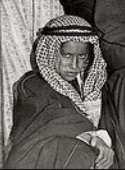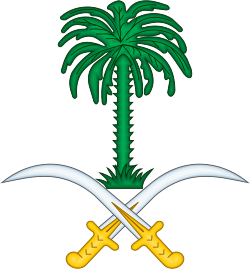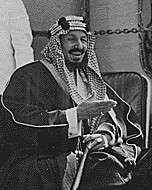Nasser bin Abdulaziz Al Saud
Nasser bin Abdulaziz Al Saud (1911 – 15 September 1984) was one of the former Riyadh governors and a member of House of Saud.
| Nasser bin Abdulaziz Al Saud | |||||
|---|---|---|---|---|---|
 | |||||
| Governor of Riyadh Province | |||||
| In office | 1938–1951 | ||||
| Predecessor | Muhammad bin Saad bin Zaid | ||||
| Successor | Sultan bin Abdulaziz | ||||
| Monarch | Ibn Saud | ||||
| Born | 1911 Riyadh, Emirate of Nejd and Hasa | ||||
| Died | 15 September 1984 (aged 72–73) Saudi Arabia | ||||
| Spouse | Muhdi bint Ahmed Al Sudairi | ||||
| |||||
| House | House of Saud | ||||
| Father | Ibn Saud | ||||
| Mother | Bazza I | ||||
Early life and education
Prince Nasser was born in Riyadh in 1911.[1] There are other reports, giving his birth date as 1913 and as 1921.[2][3] He was the sixth son of Ibn Saud.[4] His mother was Bazza I, a Moroccan woman.[3][5] Prince Nasser had no full-brothers or full-sisters.[6] He received education in Riyadh at the school of the palace, learning Quran, horsemanship and war techniques.[1]
Riyadh governorship
In 1938, Ibn Saud appointed him as the governor of Riyadh Province.[1] However, he had to resign from his post due to an event, leading to death of one of his brothers and others. When Prince Nasser was the governor, he organized a party after which his brother Prince Mansour, then-defense minister,[7] and several foreigners died of alcohol poisoning.[8] Upon hearing of this event, Ibn Saud threw him in jail.[8] Subsequently, Nasser bin Abdulaziz lost his post and never returned to public life.[9]
Exclusion from succession
Prince Nasser was excluded from the succession to throne because of the incident occurred during his term as the Governor of Riyadh Province. Both Nasser and Prince Saad were older than Prince Fahd when the latter was appointed crown prince in 1975.[5] However, the supersession did not cause turmoil because both of them were regarded as weak contenders due to being relatively less experienced.[5] Furthermore, Prince nasser lost his chance due to "dissolute" mores. He was regarded as unsuitable for succession by the larger family.[4] His lack of accomplishment and low birth (his mother was a woman of colour from Morocco) were also factors leading to his exclusion.[10]
Personal life
One of his wives, Muhdi bint Ahmed bin Mohammed Al Sudairi, was the younger sister of his step-mother, Hassa, who was one of Ibn Saud's wives and the mother of seven influential sons, known as the Sudairi Seven.[11] Muhdi was the younger sister of Hassa bint Ahmad Al Sudairi.[12] Naseer and Muhdi had five sons: Prince Khalid, Prince Abdullah, Prince Fahd, Prince Turki and Prince Ahmed.[12]
One of Naseer's sons, Turki bin Nasser, is a former military officer and the former head of the Presidency of Meteorology and Environment (PME).[11] Another son, Mohammed bin Nasser, is the governor of Jizan Province.[13] Another son Mansour bin Nasser was one of King Abdullah's advisors.[14][15] Yet another son, Abdulaziz bin Nasser, is a businessman[16] and the father of Saud bin Abdulaziz who murdered his servant in London in 2010.[17] Abdullah bin Nasser, another son of Prince Nasser, was the president of Saudi football club Al Hilal in the 1970s.[18]
Death
Prince Nasser could not walk and used a wheelchair in his last years.[5] He died on 15 September 1984 and was buried in Riyadh.[1]
Legacy
His family founded Prince Nasser bin Abdulaziz Center for Autism, an affiliated body of the Saudi Autism Center; the center was opened in April 2012.[19][20]
Ancestry
| Ancestors of Nasser bin Abdulaziz Al Saud | |||||||||||||||||||||||||||||||||||||||||||||||||||||||||||||||||||||||||||||||||||||||||||||||||||||||||||||||||||||||||||||||||||||||||||||||||||||||||||||||||||||||||||||||||||||||||||||||||||||||||||||||||||||||||||||||||||||||||||||||||||||||||||||||||||||||||||||||||||||||||||||||||||||||||||||||||||||||||||||||||||||||||||||||||||||||||||||||||||||||||||||||||||||||||||||||||||||||||||||||||||||||||||||||||||||||||||||||||||||||||||||||||||||||||||||||||||
|---|---|---|---|---|---|---|---|---|---|---|---|---|---|---|---|---|---|---|---|---|---|---|---|---|---|---|---|---|---|---|---|---|---|---|---|---|---|---|---|---|---|---|---|---|---|---|---|---|---|---|---|---|---|---|---|---|---|---|---|---|---|---|---|---|---|---|---|---|---|---|---|---|---|---|---|---|---|---|---|---|---|---|---|---|---|---|---|---|---|---|---|---|---|---|---|---|---|---|---|---|---|---|---|---|---|---|---|---|---|---|---|---|---|---|---|---|---|---|---|---|---|---|---|---|---|---|---|---|---|---|---|---|---|---|---|---|---|---|---|---|---|---|---|---|---|---|---|---|---|---|---|---|---|---|---|---|---|---|---|---|---|---|---|---|---|---|---|---|---|---|---|---|---|---|---|---|---|---|---|---|---|---|---|---|---|---|---|---|---|---|---|---|---|---|---|---|---|---|---|---|---|---|---|---|---|---|---|---|---|---|---|---|---|---|---|---|---|---|---|---|---|---|---|---|---|---|---|---|---|---|---|---|---|---|---|---|---|---|---|---|---|---|---|---|---|---|---|---|---|---|---|---|---|---|---|---|---|---|---|---|---|---|---|---|---|---|---|---|---|---|---|---|---|---|---|---|---|---|---|---|---|---|---|---|---|---|---|---|---|---|---|---|---|---|---|---|---|---|---|---|---|---|---|---|---|---|---|---|---|---|---|---|---|---|---|---|---|---|---|---|---|---|---|---|---|---|---|---|---|---|---|---|---|---|---|---|---|---|---|---|---|---|---|---|---|---|---|---|---|---|---|---|---|---|---|---|---|---|---|---|---|---|---|---|---|---|---|---|---|---|---|---|---|---|---|---|---|---|---|---|---|---|---|---|---|---|---|---|---|---|---|---|---|---|---|---|---|---|---|---|---|---|---|---|---|---|---|---|---|---|---|---|---|---|---|---|---|---|---|---|---|---|---|---|---|---|---|---|---|---|---|---|---|---|---|---|---|---|---|---|---|---|---|---|---|---|---|---|---|---|---|---|---|---|---|---|---|---|---|---|---|---|---|---|---|---|---|
| |||||||||||||||||||||||||||||||||||||||||||||||||||||||||||||||||||||||||||||||||||||||||||||||||||||||||||||||||||||||||||||||||||||||||||||||||||||||||||||||||||||||||||||||||||||||||||||||||||||||||||||||||||||||||||||||||||||||||||||||||||||||||||||||||||||||||||||||||||||||||||||||||||||||||||||||||||||||||||||||||||||||||||||||||||||||||||||||||||||||||||||||||||||||||||||||||||||||||||||||||||||||||||||||||||||||||||||||||||||||||||||||||||||||||||||||||||
References
- "Princes of Riyadh". Ministry of Interior. Archived from the original on 19 November 2013. Retrieved 26 December 2018.
- "السِّير الذاتية للشخصيات، في المملكة العربية السعودية". Al Moqatel. Retrieved 3 December 2012.
- Winberg Chai (22 September 2005). Saudi Arabia: A Modern Reader. University Press. p. 193. ISBN 978-0-88093-859-4.
- Nabil Mouline (April–June 2012). "Power and generational transition in Saudi Arabia" (PDF). Critique Internationale. 46: 1–22. Retrieved 24 April 2012.
- Simon Henderson (1994). "After King Fahd" (Policy Paper). Washington Institute. Retrieved 2 February 2013.
- "Appendix 6. The Sons of Abdulaziz" (PDF). Springer. Retrieved 13 August 2020.
- "Land Forces History". Royal Saudi Land Forces. Retrieved 26 May 2012.
- Michael Herb (1999). All in the family. Albany: State University of New York Press. p. 102. ISBN 0-7914-4168-7.
- "The new succession law preserves the monarchy". Wikileaks. Retrieved 21 April 2012.
- Talal Kapoor (1 November 2007). "The Kingdom:Succession in Saudi Arabia (part two)". Datarabia. Retrieved 11 May 2012.
- "His Royal Highness Prince Turki bin Nasser bin Abdullaziz al Saud". Saudi Environmental Society. Archived from the original on 3 November 2013. Retrieved 24 May 2012.
- Joseph A. Kechichian (2001). Succession in Saudi Arabia. New York: Palgrave.
- "Prince Mohammed bin Nasser sponsors the inauguration ceremony of the Saudi Biology Association conference at Jazan University". Jazan University. Retrieved 9 June 2012.
- "King Abdulla Arrives In Makkah From Jeddah". Bahrain News Agency. 17 June 2012. Retrieved 24 June 2012.
- "Archive 2007". UK Royal Family. October 2007. Retrieved 10 August 2020.
- "HRH Prince Abdulaziz bin Nasser bin Abdulaziz Al Saud". Barger Saudia. Archived from the original on 15 December 2012. Retrieved 18 August 2012.
- "Saudi prince beat servant to death in London hotel, court hears". The Guardian. 5 October 2010. Retrieved 9 June 2012.
- Owen Amos (14 April 2019). "The footballer, the Saudi prince and the proposition". BBC. Manchester. Retrieved 5 August 2020.
- "His Highness the Minister of Defense opens Prince Nasser bin Abdulaziz Center for Autism". Riyadh Municipality. 22 April 2012. Retrieved 9 June 2012.
- "Prince Salman to open Prince Nasser bin Abdulaziz Center for Autism". Saudi Press Agency (SPA). 16 April 2012. Archived from the original on 27 September 2013. Retrieved 16 April 2012.

